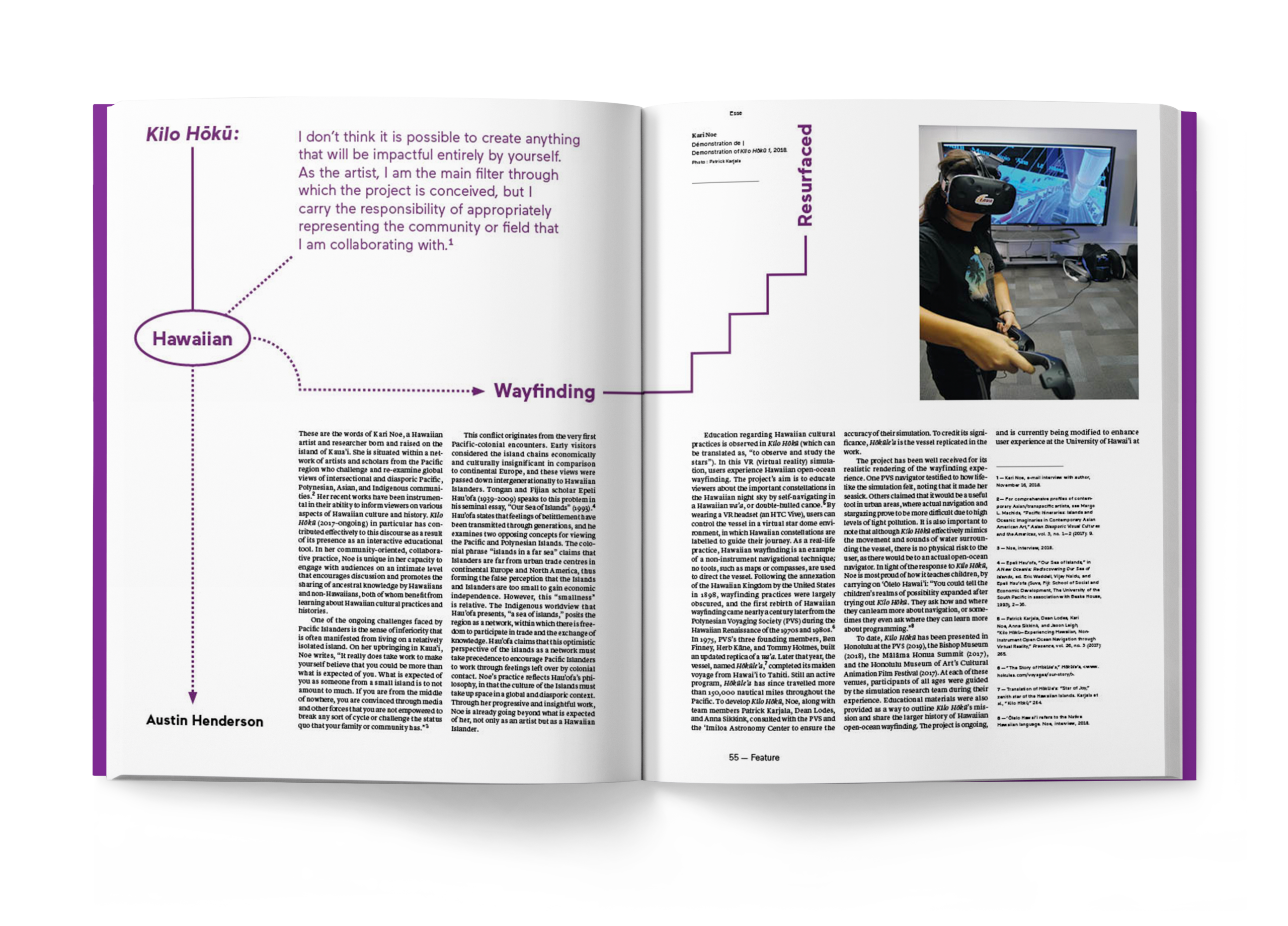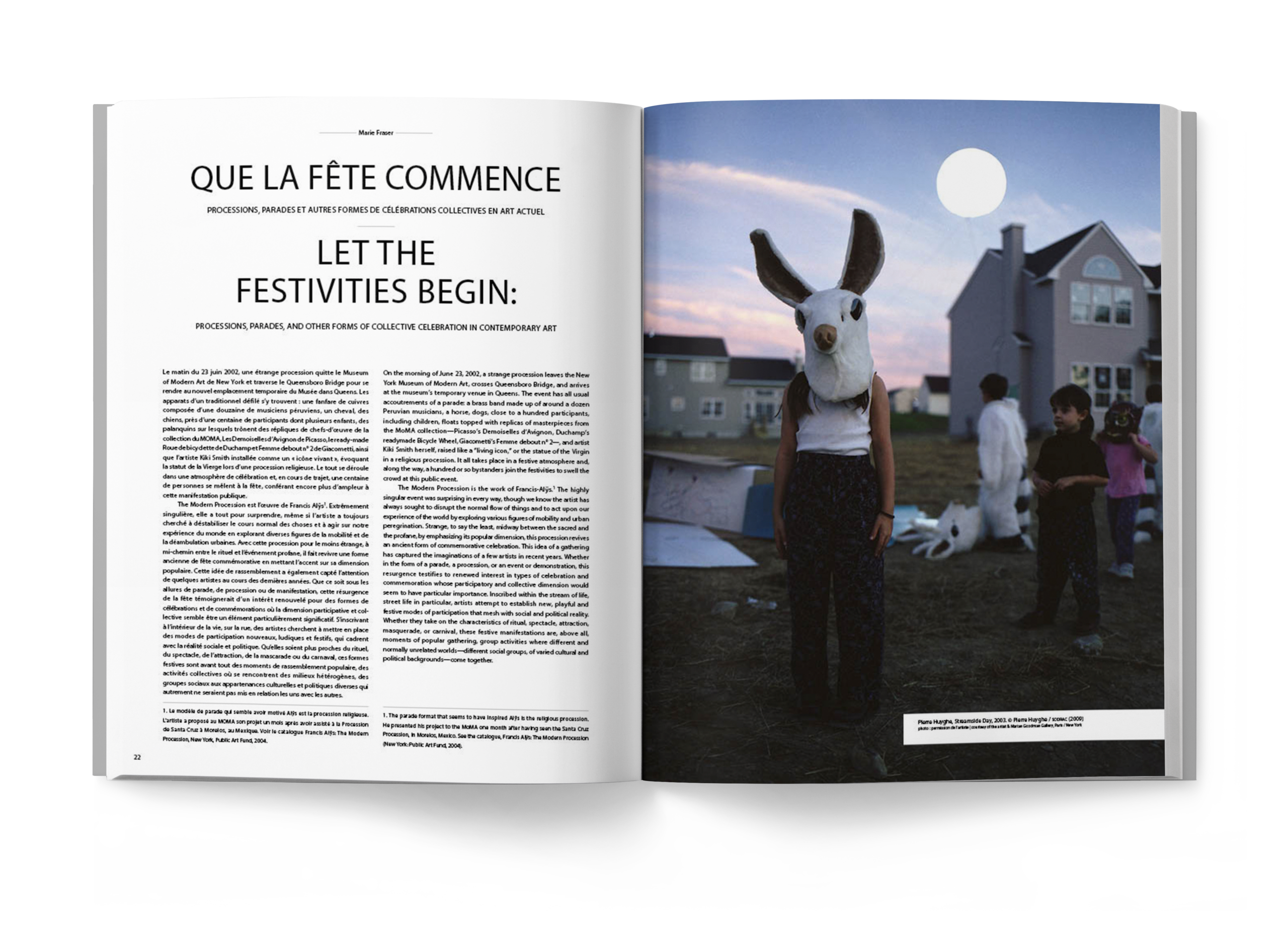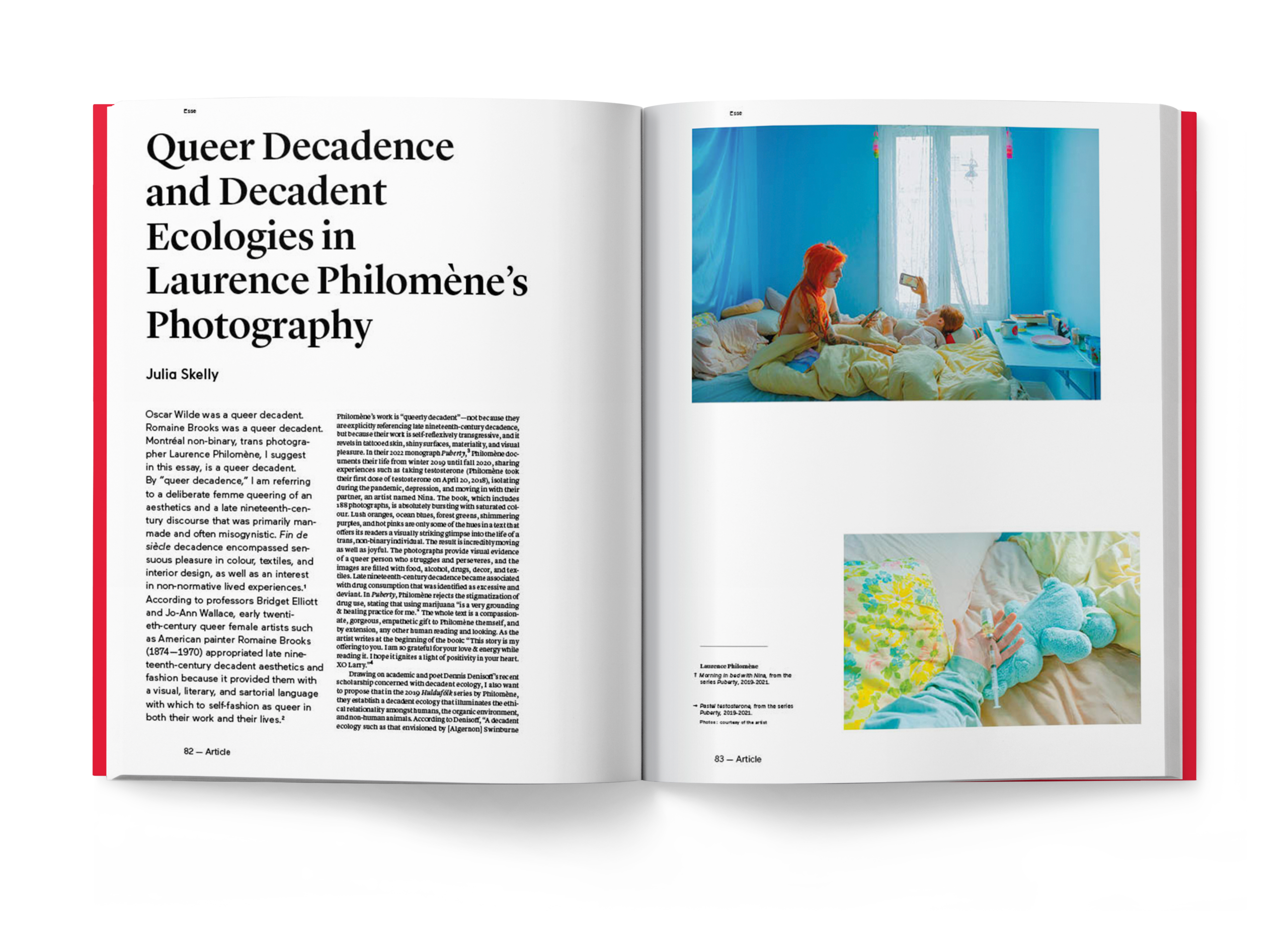Queer and Decolonial Joy as Acts of Resistance

In this digital residency in collaboration with Érudit, researcher, author and curator Renata Azevedo Moreira explores the concept of “decolonial joy”, highlighting its transformative and activist power for marginalized communities. She links joy to healing, liberation and solidarity, with joy fueling social change and fostering hope, self-determination and the creation of alternative futures.
Go deeper.
Do not be afraid to disturb this surface,
to set its limpidity in motion.
Be like the wind that shakes these trees.1 1 - Henry Lefebvre, Rhythmanalysis: Space, Time and Everyday Life, trans. S. Elden and G. Moore (London: Continuum, [1994] 2004).
I have been thinking about the transformative power of joy and its derivatives—pleasure, happiness, hope—for quite some time now. In previous texts, I have explored what I named “critical pleasure,” which stems from a queer understanding of joy that does not oppose it to pain or suffering but focuses instead on the critical role that pleasure may play in profound aesthetic experiences.2 2 - Additya Aggarwal, Elida Schogt, and Fan Wu (Eds.), Imagining Futures of Experimental Media (Toronto: Pleasure Dome, National Indigenous Media Arts Coalition, and Oddside Arts, 2023). In what has been a pivotal contribution to these reflections, I have recently confronted my own transitory identity during an extended stay in my homeland, Brazil, after many years in Canada. The contrasts between being an immigrant Latina in North America and a White Brazilian back home catapulted me into questions of privilege, territorial contexts, and of course, coloniality.
I am uncertain about the full extent to which this shift will reshape my life and curatorial practice, but I feel in my body the blissful effects of being surrounded by a community that shares my language, cultural background, and social history. In fact, “community” was the main concept that came back over and over again during my readings about joy in Esse’s and Érudit’s archives. It is a complex idea with multiple meanings, yet it often conveys the sense of comfort and trust found when we are among our peers. Be it in temporary artistic gatherings and protests or through the long-lasting impacts of belonging to a larger group, joy seems to be ultimately tied to building real, heartfelt connections. As the Puerto Rican scholar and coiner of the term “decolonial joy” Frances Negrón-Muntaner simply puts it, quoting Croatian theologian Miroslav Volf “Joy is best experienced in community. Joy seeks company.”3 3 - F. Negrón-Muntaner, “Decolonial Joy: Theorizing From the Art of Valor & Cambio,” in Theorizing Cultures of Equality, ed. S. Clisby, M. Johnson, and J. Turner (New York: Routledge, 2020), 188. When joy is involved in the imagining of new worlds, a desire that is often at the baseline of contemporary art practices, it can become unstoppable and revolutionary.
Decolonial Joy and the Power of Collectivity
Decolonial joy is not binary. Its existence does not exclude the presence of unhappiness and trauma. On the contrary, it often originates from such feelings and from the structural and generational repercussions of coloniality. As widely discussed in postcolonial literature, coloniality points toward long-term patterns of power that emerge from colonialism, which is the practice of one nation’s domination and control over the autonomy and sovereignty of another nation. Coloniality is thus the systemic result of colonialism and can be felt in several different aspects of contemporary life. It lies in the production of knowledge, in the predominance of some spoken languages over others, in the perceived superiority of one culture over another, and in all kinds of discrimination. The Puerto Rican philosopher Nelson Maldonado-Torres explains the brutal origins of this concept during the modern age, which can elucidate its myriad consequences: “The barbarian was a racialized self, and what characterized this racialization was a radical questioning or permanent suspicion regarding the humanity of the self in question.”4 4 - N. Maldonado-Torres, “On the Coloniality of Being: Contributions to the Development of a Concept,” Cultural Studies 21, no. 2–3 (2007): 240 (emphasis added).
“Permanent suspicion” is a brilliant description of the constant discomfort felt by people of colour in colonized lands, a feeling to which I can personally relate, having been an immigrant in two different countries in the Global North. The situation is analogous to the legal right of presumption of innocence in many countries, but in the opposite sense: BIPOCs are often considered guilty until proven innocent, or presumed inferior, less capable, or less trustworthy until they can consistently and repeatedly attest to the contrary. Coloniality has long-lasting repercussions that can impact a people’s collective understanding of itself. The article written by Austin Henderson, “Kilo Hōkū: Hawaiian Wayfinding Resurfaced,” published in Esse in 2020, starts with notes from the Hawaiian artist Kari Noe, whose work is the main subject: It really does take work to make yourself believe that you could be more than what is expected of you. What is expected of you as someone from a small island is to not amount to much. If you are from the middle of nowhere, you are convinced through media and other forces that you are not empowered to break any sort of cycle or challenge the status quo that your family or community has.
Interestingly, as Henderson shows, a community might also be a source of perceived limitation. This trait is comparable to the notion of a safe space that, though offering protection, might also potentially restrain. In the particular lived experienced of Noe, these “feelings of belittlement” are caused by external stereotypical assumptions about what Hawaiian people are supposed to be and achieve. Henderson emphasizes that as this community’s aspirations have been reinforced as unachievable for generations, their members’ capacity to dream actually begins to fade, and they may actually internalize what was once an outsider perspective. This outlook is in no way exclusive to Hawaii and may be perceived by people in diverse and widely separated geographic areas who endure the effects of coloniality.
Henderson alludes to the Indigenous worldview of a “sea of islands,” developed by the Tongan and Fijian anthropologist Epeli Hau’ofa, to highlight the importance of strengthening the connection among Pacific Islands to combat colonial feelings of inferiority—that is, using networks and collectivity to expand a community. In the virtual reality work Kilo Hōkū (2018), Noe creates a simulation of Hawaiian open-ocean way-finding, a non-instrumental native navigation technique whose use was forcibly restricted by colonial powers. Noe describes visitors’ engagement with the work, which uses digital technology to re-create the experience of an ancient skill, as mind-opening and captivating; some even became interested in learning more not only about navigation but also about data programming and other subjects.
Amplifying horizons, providing hope and the possibility for alternative futures, and allowing people to dream further are all essential parts of decolonial joy. Negrón-Muntaner’s concept gathers several different emotions tied to the desire to break free from colonial subjugation: “The cognitive process to envision decoloniality also assigns meaning to joy and materialises a ‘feeling’ for justice. In other words, what I call decolonial joy is the (active) manner by which people become aware of, reason with, and connect the emotion of joy to a desire for decolonial justice.”5 5 - Negrón-Muntaner, “Decolonial Joy,” 188.
Resistance and fighting for equality can naturally incorporate joy, for instance, when they take the form of celebratory gatherings in public spaces. In 2009, the art historian Marie Fraser published the article “Let the Festivities Begin: Processions, Parades, and Other Forms of Collective Celebration in Contemporary Art”6 6 - Accessible online.l in Esse’s twenty-fifth-anniversary issue. Her subject was an analysis of recent celebratory works of public art—among them a 2003 demonstration for the right to joy in the streets of Québec City, organized by the art centre Folie/Culture, which focuses on the promotion of mental health. It was no coincidence that the event was held on May 1, International Workers’ Day, and a cake decorated with the words “Joy lies in the class struggle” was shared among the attendees.
Fraser argues that the combination of a desire for revolution and the power of celebration can be liberating, even if fighting for the right to happiness may sound frivolous at first. It is worth noting that part of the strength of decolonial joy is showing how easy it can be to take action: calls for justice do not necessarily require enduring more hardship. They can instead emerge from authentic feelings of hope that are born from consistently designing better futures, and from being able to witness some fruits of the fight while it’s still occurring. After a closer look, one can certainly see that Folie/Culture’s parade was more than festive in its advocacy for a joy that relies on resistance to economic and social disparities. A politically engaged party embodies the essence of decolonial joy in the inseparability between a communal celebration and the battle for fairness and inclusivity.
The Joy of Feminist Struggles and Queer Existence/Resistance
In “The Virtual Museum and Female Joy in Argentina: An Exploration of the Revolt,”7 7 - D. Losiggio and N. Taccetta, “The Virtual Museum and Female Joy in Argentina: An Exploration of the Revolt,” Intermédialités/Intermediality, no. 37–38 (2021): 1–28, accessible online. scholars Daniela Losiggio and Natalia Taccettaapply the art historian Griselda Pollock’s idea of “virtual feminist museums” to their study of the Argentinian abortion rights movement in 2018–20. The protests that swept through the streets of Buenos Aires during that period resulted in the legalization of abortion in the country, which is considered a critical moment for other womxn-rights movements across Latin America (Colombia and Mexico followed Argentina’s lead, decriminalizing abortion in 2022 and 2023, respectively).
Losiggio and Taccetta analyze the photo-based project of the M.A.F.I.A. collective. Photographers Lucía Prieto and Guido Piotrkowski captured hundreds of images of womxn smiling, singing, and allowing themselves to finally feel joy after securing the legal right to abortion in Argentina. It is a remarkable documentation, especially when we consider how historically controversial the conceptualization of joy has been within feminist literature. One of the most important feminist scholars of the twenty-first century, Sara Ahmed, problematizes the “happiness duty” that disproportionately affects womxn. Emily Current dissects this concept in the 2022 article “Le refus de se taire: l’écriture de la maladie comme travail féministe.”8 8 - E. Current, “Le refus de se taire: l’écriture de la maladie comme travail féministe,” Voix plurielles 19, no. 3 (2022): 631–52, accessible online. Ahmed shows that society’s expectations for womxn to look grateful for whatever they’re given force them to remain silent when facing heteronormative oppression.
Current sees the killjoy as an encouragement for womxn to raise their voices against the subjugation that hides behind patriarchal assumptions of what makes them joyful. For instance, we can argue that the genuine, spontaneous joy captured by the M.A.F.I.A. collective was born from a movement that consistently and firmly resisted sexist presumptions what feminine happiness is supposed to feel like. In other words, if the system requires womxn to be happy whatever the circumstances of their pregnancies are, feminist killjoys will demand the right to happiness when they are legally allowed to interrupt undesired pregnancies. Here, decolonial joy rises from the lived experience of trauma: what a liberating moment it was for thousands of womxn to allow themselves to feel joy with the end of catastrophic death rates related to clandestine abortions.
All of M.A.F.I.A.’s photographs portray “visible joy and the possibility of an atmosphere of celebration in the midst of an uprising.”9 9 - Losiggio and Taccetta, “The Virtual Museum.” 1–2. Losiggio and Taccetta show how the social tragedy linked to the insecurities of clandestine abortion was gradually replaced by a general sense of hope, even though activists faced consistent “pro-life” efforts to label them as “pro-death.” This is a great example of revolutionary joy, as the authors explain: “Joy, as we define it, is always knowledge of oneself in a collective, that is, in relation to other beings. That understanding—singular and collective at once—enables agency.”10 10 - Ibid., 12.
Beyond the excitement of festive gatherings and the adrenaline of political demonstrations, joy can also be found in the quiet of home. Especially for queer folks who have often had to fight unique battles with their own bodies, being able to find peace within those very bodies is reason for extraordinary joy. In 2023, I curated the group exhibition We, the Self at The Next Contemporary gallery in Toronto, focusing on the intricacies of queer self-portraiture. Among the works on display were photographs and a video from the Montréal-based artist Laurence Philomène’s Puberty series, a striking, neon-coloured sequence portraying moments of daily life while undergoing hormone treatment for gender transition during the pandemic. The first aspect that connected me to this work was the pure, abundant joy emanating from it. Philomène shared that one of their motivations for the project was to reveal that beside pain and struggle, queer life is also filled with gentleness, sweetness, and beauty.
In the article “Queer Decadence and Decadent Ecologies in Laurence Philomène’s Photography,” published in Esse, Julia Skelly insightfully describes this quality in Philomène’s oeuvre: “Their work is self-reflexively transgressive, and it revels in tattooed skin, shiny surfaces, materiality, and visual pleasure.”11 11 - Accessible online. Analyzing Puberty, an artist book that is part of the same series, Skelly comments on the uniquely compassionate and empathetic nature of Philomène’s work, which is capable of building feelings of kinship even in folks who do not have a similar lived experience. Here, we see that the collective dimension of decolonial joy can also exist in autobiographical practices that are conceived as more solitary: it suffices that they are capable of evoking sincere solidarity between artists and audiences.
Lastly, in the 2021 piece “Radical Care and Decolonial Futures: Conversations on Identity, Health, and Spirituality with Indigenous Queer, Trans, and Two-Spirit Youth,”12 12 - J. Ansloos, D. Zantingh, K. Ward, S. McCormick, and C. Bloom Siriwattakanon, “RADICAL CARE AND DECOLONIAL FUTURES: CONVERSATIONS ON IDENTITY, HEALTH, AND SPIRITUALITY WITH INDIGENOUS QUEER, TRANS, AND TWO-SPIRIT YOUTH,” International Journal of Child, Youth and Family Studies 12, no. 3–4 (2021): 74–103, accessible online. Indigenous researchers Jeffrey Ansloos, Deanna Zantingh, Katelyn Ward, Samantha McCormick, and Chutchaya Bloom Siriwattakanon discuss their encounters with five young Indigiqueer activists based in Turtle Island. The authors’ goal was to deepen knowledge about how Indigiqueer youths are storying their identities and building their own, particular ideas of what it means to create decolonial futures. It is a thorough, uncommon study revealing what really matters for a community of Indigenous and queer young folks, a dimension rarely approached in academic research. One of the group’s main findings is the following: “Love, joy, belonging, tenderness, responsibility, mindfulness, and sovereignty were central to guiding the imagination and actions of the five young people in our study. The good life is grounded in loving, and that loving, manifested by young people even during the colonial present, is a type of worlding… this centring of Indigenous social ethics in the work of young people prefigures a powerful decolonial ‘elsewhere.’”
The possibility of a “decolonial elsewhere” rooted in joy is not an ending to this story, but an entry point for many other stories yet to be told, and still to be created.
Renata Azevedo Moreira is a Brazilian researcher, author, and curator based in Tkaronto. Queer, feminist, and postcolonial gestures inspire her practice, which highlights collaboration and inclusivity by striving to create space for QBIPOC artists in different stages of their careers. In 2021, Renata earned a PhD in communication studies from the Université de Montréal, exploring the material and discursive intersections of curatorial work and media art creation. Her writing has appeared in Border Crossings, Esse arts + opinions, the book Imagining Futures of Experimental Media (Pleasure Dome) and Baron Mag, where she published the exhibition review column L’art au rendez-vous.
Links to the articles cited: Austin Henderson Marie Fraser Daniela Losiggio and Natalia Taccettaapply Emily Current Julia Skelly Jeffrey Ansloos, Deanna Zantingh, Katelyn Ward, Samantha McCormick, and Chutchaya Bloom Siriwattakanon










